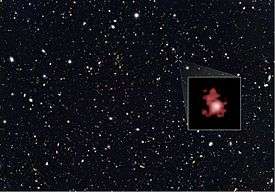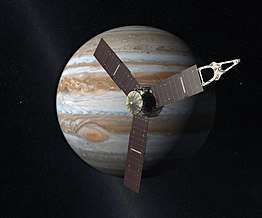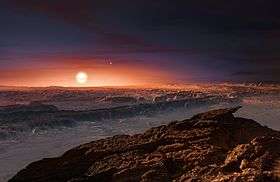2016 EU85
2016 EU85 is an asteroid, classified as near-Earth object and potentially hazardous asteroid of the Apollo group, approximately 400 meters in diameter. It was first observed on 10 March 2016, by the Pan-STARRS survey at Haleakala Observatory, Hawaii, United States.[1][2]
| Discovery [1][2] | |
|---|---|
| Discovered by | Pan-STARRS |
| Discovery site | Haleakala Obs. |
| Discovery date | 10 March 2016 (discovery: first observation only) |
| Designations | |
| 2016 EU85 | |
| Orbital characteristics [1] | |
| Epoch 4 September 2017 (JD 2458000.5) | |
| Uncertainty parameter 3 | |
| Observation arc | 1.42 yr (518 days) |
| Aphelion | 2.7400 AU |
| Perihelion | 0.9561 AU |
| 1.8480 AU | |
| Eccentricity | 0.4826 |
| 2.51 yr (918 days) | |
| 303.30° | |
| 0° 23m 32.28s / day | |
| Inclination | 2.5966° |
| 359.44° | |
| 23.527° | |
| Earth MOID | 0.0065 AU (2.5 LD) |
| Physical characteristics | |
| Dimensions | 0.4 km (est. at 0.24)[3] |
| 19.2[1] | |
Orbit
2016 EU85 orbits the Sun at a distance of 1.0–2.7 AU once every 2 years and 6 months (918 days). Its orbit has an eccentricity of 0.48 and an inclination of 3° with respect to the ecliptic.[1] It has an Earth minimum orbital intersection distance of 0.0065 AU (972,000 km) which translates into 2.5 lunar distances.[1]
Torino scale
It is currently rated at level 0[4] after being rated at level 1 on the Torino Scale by the NEODyS system.[5] It was upgraded to level 1 on 25 March 2016 but downgraded on 30 March 2016. On the Sentry system it did not cross the threshold between the two levels, due to a lower computed impact probability. The asteroid is estimated to have a diameter of 440 metres (1,440 ft; 480 yd).[6] The observation arc was then increased to of 78 days.[7]
When rated at Torino Scale level 1, there was a 0.0012% chance or a 1 in 83,000 chance of the asteroid colliding with the Earth, corresponding to a 99.9988% chance the asteroid will miss the Earth.[8] 2016 EU85 had been observed 14 times[9] at the observatories Mauna Kea (568), Apache Point (705), Pan-STARRS 1 Haleakala (F51) and Magdalena Ridge Observatory (H01).[10]
2016 EU85 was subsequently removed from the list of possible impactors thanks to prediscovery observations found in the Pan-STARRS archive.
Observations
2016 EU85 was observed with the Spacewatch 1.8-meter telescopes and also the Vatican Advanced Technology Telescope.[11][12]
References
- "JPL Small-Body Database Browser: (2016 EU85)" (2017-06-14 last obs.). Jet Propulsion Laboratory. Retrieved 2 August 2017.
- "2016 EU85". Minor Planet Center. Retrieved 2 August 2017.
- "Asteroid Size Estimator". CNEOS/JPL. Retrieved 1 August 2017.
- "CRT Page". www.hohmanntransfer.com. Retrieved 28 April 2016.
- "NEODyS". newton.dm.unipi.it. Retrieved 28 April 2016.
- "2016-03-15 Tracking News". www.hohmanntransfer.com. Retrieved 28 April 2016.
- "Risky Asteroid 2016 EU85 – Astrometrics". The Spaceport V5.5. Retrieved 28 April 2016.
- Network, Las Cumbres Observatory Global Telescope. "2016 EU85 details | LCOGT NEOx". lcogt.net. Retrieved 28 April 2016.
- "MPEC 2016-E142: 2016 EU85". www.minorplanetcenter.org. Retrieved 28 April 2016.


